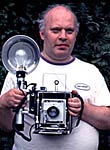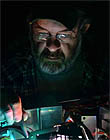|
|
This topic comprises 2 pages: 1 2
|
|
Author
|
Topic: Opera simulcast in cinemas
|
|
|
Stephen Furley
Film God

Posts: 3059
From: Coulsdon, Croydon, England
Registered: May 2002
|
 posted 03-20-2007 05:24 AM
posted 03-20-2007 05:24 AM




Ron,
Could you clarify what you mean by 'simulcast' please? It has, or had, a meaning over here which wouldn't make sense in this context. Was this literally a live transmission of the performance as it took place, or a recording transmitted to various theatres, or what? If either of the above, do you know how the signal was transmitted to the theatres, and the resolution and sound format used? Obviously the sound would have been important for something like opera, and it's unlikely that a simple two-channel stereo system would be acceptable with a large screen. My guess would be multi-channel coded onto an AES pair with Dolby E, and then embedded into a HD-SDI stream for transmission; that would be a lot of data to handle.
At one time the showing of live events in cinemas was quite commom; demonstrations were given as far back as the '30s, and in 1951 live television (along with 3D film with stereo sound, but not widescreen) was shown in the 'Telekinema' at the Festival of Britain. In 1953 the Coronation of the present Queen was shown almost live (I'm told that it was actually film recorded from a video signal at the cinema, and the film processed and projected a few minutes later. A bit like the Baird intermediate film system in reverse! By my day, in the '60s most people had television sets at home, and the showing of live events had almost died out. About the only ones that I remember seeing advertised were occasional boxing matches, which at least three cinemas in London showed. I think even this had just about finished by the late '60s, and since I had no interest whatsoever in boxing, I never saw the system. It would have been black and white, with mono sound, and I doubt that the quality was that good. I don't know if the picture was the full size of the screen.
Technology has moved on a lot in the last 40 years; last year, or was it the one before?, the Odeon Leicester Square screened some of te football World Cup matches live and, I'm told, got reasonable audiences for them. I believe that this was at standard broadcast HD television resolution. There's little HD television broadcast in this country at present, almost none when these matches were shown, and few people have it at home.
Sport always seems to have been a more popular subject than art for live screenings, and there will always be the problem of the time difference when showing a live event around the World. While watching an opera from New York in mid afternoon in London wouldn't be too bad, you'd probably have to do it at a weekend, or too many people would be at work, going out to watch it in the middle of the night in Tokyo or Beijing might be a different matter. This is obviously somewhat different to a sporting match, where seeing it live can be important.
I hadn't heard about this, do you know where it was shown?
| IP: Logged
|
|
Carl Martin
Phenomenal Film Handler
Posts: 1424
From: Oakland, CA, USA
Registered: Feb 2002
|
 posted 03-20-2007 06:17 AM
posted 03-20-2007 06:17 AM





here is an excerpt from the bay area reporter:
Went, saw, was not conquered
The Met's HD movie venture kicks off in select theaters
Published 03/15/2007
by Jason Victor Serinus
Reality clash. I had anticipated writing an enthusiastic review of the Metropolitan Opera's groundbreaking embrace of new technologies. After all, the country's most prestigious opera house, whose long-standing conservatism delayed adoption of supertitles (simultaneously-projected English translations) until long after they appeared in other major US houses, has countered the decline of opera on the airwaves with an unprecedented international outreach initiative. In December, the Met announced High-Definition TV and movie-theater airings of six star-studded productions from its current season. So successful have the movie showings proved that 90% capacity audiences of nearly 30,000 people have resulted in encore runs of two operas, the world premiere of Tan Dun's The First Emperor and June Taymor's English-language take on Mozart's The Magic Flute.
Last Wednesday, I visited the UA Emery Bay Stadium 10 (one of three Bay Area theaters booking the broadcasts) for the first of two encore satellite broadcasts of The First Emperor. I anticipated vivid colors, wonderful surround sound, and an HD experience that would foster unprecedented intimacy between singers and audience. Instead, I encountered blanched, washed-out colors; an irritating, ringing sound system with poor bass and a complete absence of midrange warmth; and far less clarity than I had hoped for.
I can't account for the discrepancy. According to the theater's manager, their tech had declared everything A-OK just two days earlier. Furthermore, theaters have no control over broadcasts per se, which arrive via satellite feed. At least the Regal Emery Bay fared better than AMC's Bay Street 16, a quarter-mile away, which refunded patrons' money after the picture quit in the middle of the opera. One of those patrons, who dashed to the Regal to see the rest of the opera, reported that the AMC's malfunctioning HD machine was not even broadcasting at the highest possible resolution.
| IP: Logged
|
|
|
|
|
|
|
|
Chris Parry
Film Handler
Posts: 8
From: Richmond BC Canada
Registered: Feb 2007
|
 posted 03-21-2007 12:39 AM
posted 03-21-2007 12:39 AM





Be that as it may, I can tell you that our local Cineplex has been showing these every Saturday morning for a few months now, and they're not only packing them in, but it's a heck of a show.
For starters, a live showing of a Saturday matinee performance at The Met is piped in via satellite once every month or so, and on off-weeks they've been running 'encore performances' that are reruns of the live show. Tickets run at premium prices - $19 a head in Vancouver BC. The shows happen at 10:30am on the west coast, which is a little early for the teenagers, but right on for the older crowds that love opera.
I saw The First Emperor and enjoyed it a lot, and I'm no opera fan. My wife is, however, and has gone to most of them - Magic Flute, Barber of Seville, etc. She said the Eugene Onegin performance was the best she's ever seen - live or otherwise - and she's seen literally hundreds of opera performances all over the world. Her father, who is another boffin for opera, backed that up.
What's interesting is that some of these have a cinema tie-in. For example, The First Emperor was directed by Zhang Yimou, and was composed by the guy who composed the score for Hero and House of Flying Daggers. The costume designer had previously designed for Kurosawa films.
As for attendances - the first show blew their expectations away, according to reports. I can tell you that the showings we've seen have played to crowds generally between 2/3 and 1/2 full, for a 300-seater auditorium. What was surprising was, a good 1/3 of those present were teens or young adults.
To be honest, I think it's a great move, and I think it would really lend itself to Broadway, or big concerts. You might think that folks in Podunk don't care for things like opera or Broadway, but given a chance to see something on a grand scale that they'd otherwise never get to see, most folks will take a chance on a ticket, just so they can say they did.
| IP: Logged
|
|
|
|
|
|
|
|
|
|
|
|
Chris Parry
Film Handler
Posts: 8
From: Richmond BC Canada
Registered: Feb 2007
|
 posted 03-21-2007 06:28 PM
posted 03-21-2007 06:28 PM





The reason opera has such a small following in general (ditto most live performance formats) is because the price to put on a production (and thus, to buy a ticket) is really freakin' high.
But by increasing the potential audience to hundreds of thousands, and lowering the price point to get in as these shows have been doing, people do come out of the woodwork. There are a lot of folks at these shows who haven't seen the inside of a cineplex since Jimmy Carter was in office.
And the fact that these shows are just not some fat woman in a viking helmet busting out a few numbers, but instead are humungous big budget productions featuring well known singers like Placido Domingo, and directors like Zhang Yimou and Julie Taymor (Titus, Frida, The Lion King), open it up to new people who could usually not give a damn but can appreciate a spectacle (like me). The sub-titles and hand-outs at the theater that tell the story and give a little background also help make it more accessible, even if they do mostly end up on the floor.
Let's face it, most people, if they took a vacation in New York, would go see the opera at the Met or a Broadway show just to say they did, and they'd pay a hundred bucks to do it. This allows them to do it between dropping off the kids at soccer practice and hitting Costco.
BTW, according to the Met's website, they're happy for more cinemas to take the feed.
| IP: Logged
|
|
|
|
|
|
|
|
All times are Central (GMT -6:00)
|
This topic comprises 2 pages: 1 2
|
Powered by Infopop Corporation
UBB.classicTM
6.3.1.2
The Film-Tech Forums are designed for various members related to the cinema industry to express their opinions, viewpoints and testimonials on various products, services and events based upon speculation, personal knowledge and factual information through use, therefore all views represented here allow no liability upon the publishers of this web site and the owners of said views assume no liability for any ill will resulting from these postings. The posts made here are for educational as well as entertainment purposes and as such anyone viewing this portion of the website must accept these views as statements of the author of that opinion
and agrees to release the authors from any and all liability.
|

 Home
Home
 Products
Products
 Store
Store
 Forum
Forum
 Warehouse
Warehouse
 Contact Us
Contact Us




 Printer-friendly view of this topic
Printer-friendly view of this topic












![[uhoh]](graemlins/uhoh.gif)


![[Confused]](confused.gif)



